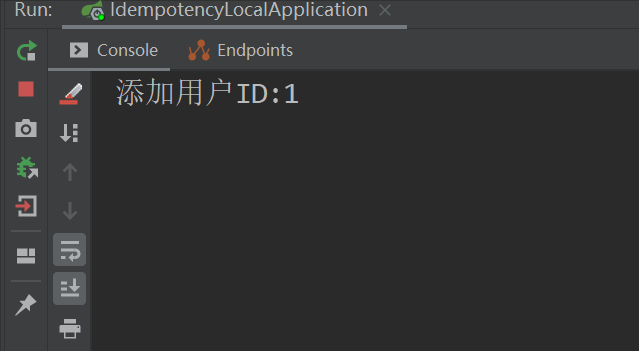Java防止數(shù)據(jù)重復提交的方法有哪些
本篇內(nèi)容介紹了“Java防止數(shù)據(jù)重復提交的方法有哪些”的有關(guān)知識,在實際案例的操作過程中,不少人都會遇到這樣的困境,接下來就讓小編帶領(lǐng)大家學習一下如何處理這些情況吧!希望大家仔細閱讀,能夠?qū)W有所成!
淶源ssl適用于網(wǎng)站、小程序/APP、API接口等需要進行數(shù)據(jù)傳輸應用場景,ssl證書未來市場廣闊!成為成都創(chuàng)新互聯(lián)公司的ssl證書銷售渠道,可以享受市場價格4-6折優(yōu)惠!如果有意向歡迎電話聯(lián)系或者加微信:18980820575(備注:SSL證書合作)期待與您的合作!
模擬用戶場景
根據(jù)朋友的反饋,大致的場景是這樣的,如下圖所示:

簡化的模擬代碼如下(基于 Spring Boot):
import org.springframework.web.bind.annotation.RequestMapping; import org.springframework.web.bind.annotation.RestController; @RequestMapping("/user") @RestController public class UserController { /** * 被重復請求的方法 */ @RequestMapping("/add") public String addUser(String id) { // 業(yè)務代碼... System.out.println("添加用戶ID:" + id); return "執(zhí)行成功!"; } }于是磊哥就想到:通過前、后端分別攔截的方式來解決數(shù)據(jù)重復提交的問題。
前端攔截
前端攔截是指通過 HTML 頁面來攔截重復請求,比如在用戶點擊完“提交”按鈕后,我們可以把按鈕設(shè)置為不可用或者隱藏狀態(tài)。
執(zhí)行效果如下圖所示:

前端攔截的實現(xiàn)代碼:
<html> <script> function subCli(){ // 按鈕設(shè)置為不可用 document.getElementById("btn_sub").disabled="disabled"; document.getElementById("dv1").innerText = "按鈕被點擊了~"; } </script> <body style="margin-top: 100px;margin-left: 100px;"> <input id="btn_sub" type="button" value=" 提 交 " onclick="subCli()"> <div id="dv1" style="margin-top: 80px;"></div> </body> </html>但前端攔截有一個致命的問題,如果是懂行的程序員或非法用戶可以直接繞過前端頁面,通過模擬請求來重復提交請求,比如充值了 100 元,重復提交了 10 次變成了 1000 元(瞬間發(fā)現(xiàn)了一個致富的好辦法)。
所以除了前端攔截一部分正常的誤操作之外,后端的攔截也是必不可少。
后端攔截
后端攔截的實現(xiàn)思路是在方法執(zhí)行之前,先判斷此業(yè)務是否已經(jīng)執(zhí)行過,如果執(zhí)行過則不再執(zhí)行,否則就正常執(zhí)行。
我們將請求的業(yè)務 ID 存儲在內(nèi)存中,并且通過添加互斥鎖來保證多線程下的程序執(zhí)行安全,大體實現(xiàn)思路如下圖所示:

然而,將數(shù)據(jù)存儲在內(nèi)存中,最簡單的方法就是使用 HashMap 存儲,或者是使用 Guava Cache 也是同樣的效果,但很顯然 HashMap 可以更快的實現(xiàn)功能,所以我們先來實現(xiàn)一個 HashMap 的防重(防止重復)版本。
1.基礎(chǔ)版——HashMap
import org.springframework.web.bind.annotation.RequestMapping; import org.springframework.web.bind.annotation.RestController; import java.util.HashMap; import java.util.Map; /** * 普通 Map 版本 */ @RequestMapping("/user") @RestController public class UserController3 { // 緩存 ID 集合 private Map<String, Integer> reqCache = new HashMap<>(); @RequestMapping("/add") public String addUser(String id) { // 非空判斷(忽略)... synchronized (this.getClass()) { // 重復請求判斷 if (reqCache.containsKey(id)) { // 重復請求 System.out.println("請勿重復提交!!!" + id); return "執(zhí)行失敗"; } // 存儲請求 ID reqCache.put(id, 1); } // 業(yè)務代碼... System.out.println("添加用戶ID:" + id); return "執(zhí)行成功!"; } }實現(xiàn)效果如下圖所示:

存在的問題:此實現(xiàn)方式有一個致命的問題,因為 HashMap 是無限增長的,因此它會占用越來越多的內(nèi)存,并且隨著 HashMap 數(shù)量的增加查找的速度也會降低,所以我們需要實現(xiàn)一個可以自動“清除”過期數(shù)據(jù)的實現(xiàn)方案。
2.優(yōu)化版——固定大小的數(shù)組
此版本解決了 HashMap 無限增長的問題,它使用數(shù)組加下標計數(shù)器(reqCacheCounter)的方式,實現(xiàn)了固定數(shù)組的循環(huán)存儲。
當數(shù)組存儲到最后一位時,將數(shù)組的存儲下標設(shè)置 0,再從頭開始存儲數(shù)據(jù),實現(xiàn)代碼如下:
import org.springframework.web.bind.annotation.RequestMapping; import org.springframework.web.bind.annotation.RestController; import java.util.Arrays; @RequestMapping("/user") @RestController public class UserController { private static String[] reqCache = new String[100]; // 請求 ID 存儲集合 private static Integer reqCacheCounter = 0; // 請求計數(shù)器(指示 ID 存儲的位置) @RequestMapping("/add") public String addUser(String id) { // 非空判斷(忽略)... synchronized (this.getClass()) { // 重復請求判斷 if (Arrays.asList(reqCache).contains(id)) { // 重復請求 System.out.println("請勿重復提交!!!" + id); return "執(zhí)行失敗"; } // 記錄請求 ID if (reqCacheCounter >= reqCache.length) reqCacheCounter = 0; // 重置計數(shù)器 reqCache[reqCacheCounter] = id; // 將 ID 保存到緩存 reqCacheCounter++; // 下標往后移一位 } // 業(yè)務代碼... System.out.println("添加用戶ID:" + id); return "執(zhí)行成功!"; } }3.擴展版——雙重檢測鎖(DCL)
上一種實現(xiàn)方法將判斷和添加業(yè)務,都放入 synchronized 中進行加鎖操作,這樣顯然性能不是很高,于是我們可以使用單例中著名的 DCL(Double Checked Locking,雙重檢測鎖)來優(yōu)化代碼的執(zhí)行效率,實現(xiàn)代碼如下:
import org.springframework.web.bind.annotation.RequestMapping; import org.springframework.web.bind.annotation.RestController; import java.util.Arrays; @RequestMapping("/user") @RestController public class UserController { private static String[] reqCache = new String[100]; // 請求 ID 存儲集合 private static Integer reqCacheCounter = 0; // 請求計數(shù)器(指示 ID 存儲的位置) @RequestMapping("/add") public String addUser(String id) { // 非空判斷(忽略)... // 重復請求判斷 if (Arrays.asList(reqCache).contains(id)) { // 重復請求 System.out.println("請勿重復提交!!!" + id); return "執(zhí)行失敗"; } synchronized (this.getClass()) { // 雙重檢查鎖(DCL,double checked locking)提高程序的執(zhí)行效率 if (Arrays.asList(reqCache).contains(id)) { // 重復請求 System.out.println("請勿重復提交!!!" + id); return "執(zhí)行失敗"; } // 記錄請求 ID if (reqCacheCounter >= reqCache.length) reqCacheCounter = 0; // 重置計數(shù)器 reqCache[reqCacheCounter] = id; // 將 ID 保存到緩存 reqCacheCounter++; // 下標往后移一位 } // 業(yè)務代碼... System.out.println("添加用戶ID:" + id); return "執(zhí)行成功!"; } }注意:DCL 適用于重復提交頻繁比較高的業(yè)務場景,對于相反的業(yè)務場景下 DCL 并不適用。
4.完善版——LRUMap
上面的代碼基本已經(jīng)實現(xiàn)了重復數(shù)據(jù)的攔截,但顯然不夠簡潔和優(yōu)雅,比如下標計數(shù)器的聲明和業(yè)務處理等,但值得慶幸的是 Apache 為我們提供了一個 commons-collections 的框架,里面有一個非常好用的數(shù)據(jù)結(jié)構(gòu) LRUMap 可以保存指定數(shù)量的固定的數(shù)據(jù),并且它會按照 LRU 算法,幫你清除最不常用的數(shù)據(jù)。
小貼士:LRU 是 Least Recently Used 的縮寫,即最近最少使用,是一種常用的數(shù)據(jù)淘汰算法,選擇最近最久未使用的數(shù)據(jù)予以淘汰。
首先,我們先來添加 Apache commons collections 的引用:
<!-- 集合工具類 apache commons collections --> <!-- https://mvnrepository.com/artifact/org.apache.commons/commons-collections4 --> <dependency> <groupId>org.apache.commons</groupId> <artifactId>commons-collections4</artifactId> <version>4.4</version> </dependency>
實現(xiàn)代碼如下:
import org.apache.commons.collections4.map.LRUMap; import org.springframework.web.bind.annotation.RequestMapping; import org.springframework.web.bind.annotation.RestController; @RequestMapping("/user") @RestController public class UserController { // 最大容量 100 個,根據(jù) LRU 算法淘汰數(shù)據(jù)的 Map 集合 private LRUMap<String, Integer> reqCache = new LRUMap<>(100); @RequestMapping("/add") public String addUser(String id) { // 非空判斷(忽略)... synchronized (this.getClass()) { // 重復請求判斷 if (reqCache.containsKey(id)) { // 重復請求 System.out.println("請勿重復提交!!!" + id); return "執(zhí)行失敗"; } // 存儲請求 ID reqCache.put(id, 1); } // 業(yè)務代碼... System.out.println("添加用戶ID:" + id); return "執(zhí)行成功!"; } }使用了 LRUMap 之后,代碼顯然簡潔了很多。
5.最終版——封裝
以上都是方法級別的實現(xiàn)方案,然而在實際的業(yè)務中,我們可能有很多的方法都需要防重,那么接下來我們就來封裝一個公共的方法,以供所有類使用:
import org.apache.commons.collections4.map.LRUMap; /** * 冪等性判斷 */ public class IdempotentUtils { // 根據(jù) LRU(Least Recently Used,最近最少使用)算法淘汰數(shù)據(jù)的 Map 集合,最大容量 100 個 private static LRUMap<String, Integer> reqCache = new LRUMap<>(100); /** * 冪等性判斷 * @return */ public static boolean judge(String id, Object lockClass) { synchronized (lockClass) { // 重復請求判斷 if (reqCache.containsKey(id)) { // 重復請求 System.out.println("請勿重復提交!!!" + id); return false; } // 非重復請求,存儲請求 ID reqCache.put(id, 1); } return true; } }調(diào)用代碼如下:
import com.example.idempote.util.IdempotentUtils; import org.springframework.web.bind.annotation.RequestMapping; import org.springframework.web.bind.annotation.RestController; @RequestMapping("/user") @RestController public class UserController4 { @RequestMapping("/add") public String addUser(String id) { // 非空判斷(忽略)... // -------------- 冪等性調(diào)用(開始) -------------- if (!IdempotentUtils.judge(id, this.getClass())) { return "執(zhí)行失敗"; } // -------------- 冪等性調(diào)用(結(jié)束) -------------- // 業(yè)務代碼... System.out.println("添加用戶ID:" + id); return "執(zhí)行成功!"; } }小貼士:一般情況下代碼寫到這里就結(jié)束了,但想要更簡潔也是可以實現(xiàn)的,你可以通過自定義注解,將業(yè)務代碼寫到注解中,需要調(diào)用的方法只需要寫一行注解就可以防止數(shù)據(jù)重復提交了,老鐵們可以自行嘗試一下(需要磊哥擼一篇的,評論區(qū)留言 666)。
擴展知識——LRUMap 實現(xiàn)原理分析
既然 LRUMap 如此強大,我們就來看看它是如何實現(xiàn)的。
LRUMap 的本質(zhì)是持有頭結(jié)點的環(huán)回雙鏈表結(jié)構(gòu),它的存儲結(jié)構(gòu)如下:
AbstractLinkedMap.LinkEntry entry;
當調(diào)用查詢方法時,會將使用的元素放在雙鏈表 header 的前一個位置,源碼如下:
public V get(Object key, boolean updateToMRU) { LinkEntry<K, V> entry = this.getEntry(key); if (entry == null) { return null; } else { if (updateToMRU) { this.moveToMRU(entry); } return entry.getValue(); } } protected void moveToMRU(LinkEntry<K, V> entry) { if (entry.after != this.header) { ++this.modCount; if (entry.before == null) { throw new IllegalStateException("Entry.before is null. This should not occur if your keys are immutable, and you have used synchronization properly."); } entry.before.after = entry.after; entry.after.before = entry.before; entry.after = this.header; entry.before = this.header.before; this.header.before.after = entry; this.header.before = entry; } else if (entry == this.header) { throw new IllegalStateException("Can't move header to MRU This should not occur if your keys are immutable, and you have used synchronization properly."); } }如果新增元素時,容量滿了就會移除 header 的后一個元素,添加源碼如下:
protected void addMapping(int hashIndex, int hashCode, K key, V value) { // 判斷容器是否已滿 if (this.isFull()) { LinkEntry<K, V> reuse = this.header.after; boolean removeLRUEntry = false; if (!this.scanUntilRemovable) { removeLRUEntry = this.removeLRU(reuse); } else { while(reuse != this.header && reuse != null) { if (this.removeLRU(reuse)) { removeLRUEntry = true; break; } reuse = reuse.after; } if (reuse == null) { throw new IllegalStateException("Entry.after=null, header.after=" + this.header.after + " header.before=" + this.header.before + " key=" + key + " value=" + value + " size=" + this.size + " maxSize=" + this.maxSize + " This should not occur if your keys are immutable, and you have used synchronization properly."); } } if (removeLRUEntry) { if (reuse == null) { throw new IllegalStateException("reuse=null, header.after=" + this.header.after + " header.before=" + this.header.before + " key=" + key + " value=" + value + " size=" + this.size + " maxSize=" + this.maxSize + " This should not occur if your keys are immutable, and you have used synchronization properly."); } this.reuseMapping(reuse, hashIndex, hashCode, key, value); } else { super.addMapping(hashIndex, hashCode, key, value); } } else { super.addMapping(hashIndex, hashCode, key, value); } }判斷容量的源碼:
public boolean isFull() { return size >= maxSize; }容量未滿就直接添加數(shù)據(jù):
super.addMapping(hashIndex, hashCode, key, value);
如果容量滿了,就調(diào)用 reuseMapping 方法使用 LRU 算法對數(shù)據(jù)進行清除。
綜合來說:LRUMap 的本質(zhì)是持有頭結(jié)點的環(huán)回雙鏈表結(jié)構(gòu),當使用元素時,就將該元素放在雙鏈表 header 的前一個位置,在新增元素時,如果容量滿了就會移除 header的后一個元素。
“Java防止數(shù)據(jù)重復提交的方法有哪些”的內(nèi)容就介紹到這里了,感謝大家的閱讀。如果想了解更多行業(yè)相關(guān)的知識可以關(guān)注創(chuàng)新互聯(lián)網(wǎng)站,小編將為大家輸出更多高質(zhì)量的實用文章!
文章標題:Java防止數(shù)據(jù)重復提交的方法有哪些
瀏覽路徑:http://m.kartarina.com/article22/jecdcc.html
成都網(wǎng)站建設(shè)公司_創(chuàng)新互聯(lián),為您提供、外貿(mào)網(wǎng)站建設(shè)、移動網(wǎng)站建設(shè)、網(wǎng)站導航、品牌網(wǎng)站制作、手機網(wǎng)站建設(shè)
聲明:本網(wǎng)站發(fā)布的內(nèi)容(圖片、視頻和文字)以用戶投稿、用戶轉(zhuǎn)載內(nèi)容為主,如果涉及侵權(quán)請盡快告知,我們將會在第一時間刪除。文章觀點不代表本網(wǎng)站立場,如需處理請聯(lián)系客服。電話:028-86922220;郵箱:631063699@qq.com。內(nèi)容未經(jīng)允許不得轉(zhuǎn)載,或轉(zhuǎn)載時需注明來源: 創(chuàng)新互聯(lián)

- 上海建站公司如何將網(wǎng)站關(guān)鍵詞優(yōu)化到搜索引擎首頁? 2020-11-24
- 網(wǎng)站關(guān)鍵詞優(yōu)化人員應該具備哪些能力和素質(zhì)呢 2016-10-30
- 網(wǎng)站改版會影響SEO關(guān)鍵詞優(yōu)化嗎? 2014-08-11
- 公司網(wǎng)站建設(shè)好之后為什么還要做網(wǎng)站關(guān)鍵詞優(yōu)化排名呢? 2016-11-15
- 進行網(wǎng)站關(guān)鍵詞優(yōu)化需要做的準備工作 2016-08-09
- 百度SEO關(guān)鍵詞優(yōu)化排名與哪些因素有關(guān) 2016-11-08
- seo優(yōu)化人員必備的seo關(guān)鍵詞優(yōu)化工具! 2014-05-12
- 關(guān)鍵詞優(yōu)化什么意思 2021-12-14
- 網(wǎng)站關(guān)鍵詞優(yōu)化不穩(wěn)定的原因有哪些? 2022-11-20
- 關(guān)鍵詞優(yōu)化需要做哪些工作? 2015-06-25
- 長尾關(guān)鍵詞優(yōu)化大技巧? 2016-10-23
- 網(wǎng)站關(guān)鍵詞優(yōu)化時,內(nèi)容收錄于外鏈那個重要呢? 2016-10-30